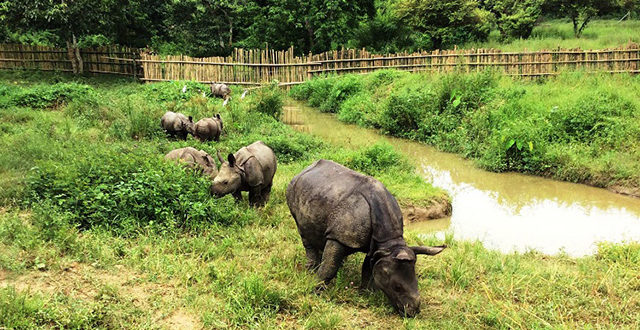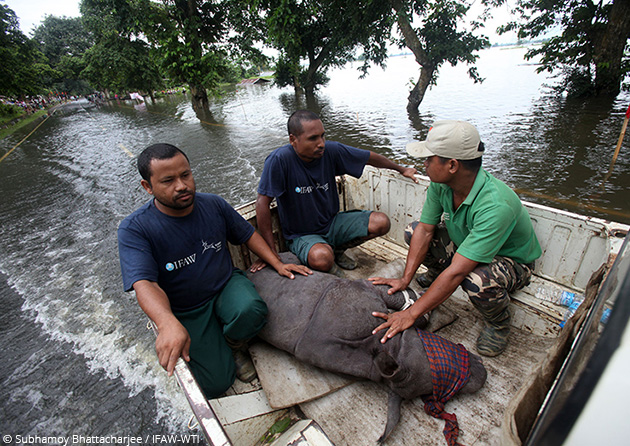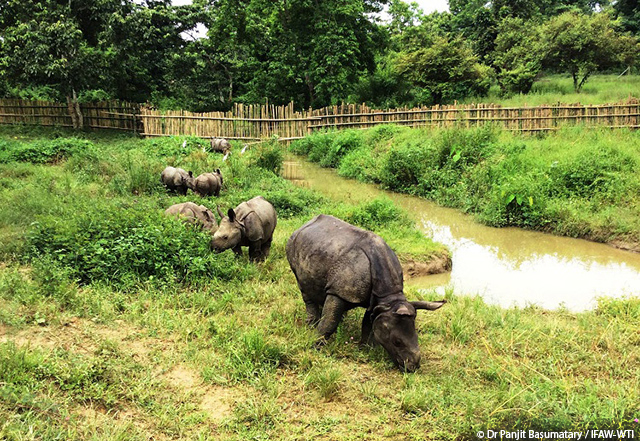On World Rhino Day: Eight Famous Orphans, Three Incredible Mothers, and Some Hair-munching Idiocy
New Delhi, September 22, 2016: Today is World Rhino Day, so mandated since 2010 as a day to raise awareness about these wonderful armoured mammals, all five living species of which – two in Africa and three in southern Asia – are threatened by habitat loss and poaching.
The Indian rhino, Rhinoceros unicornis or the Greater One-horned rhinoceros, is classified on the IUCN Red List of Threatened Species as ‘Vulnerable’. (Javan, Sumatran and Black rhinos are ‘Critically Endangered’ while White rhinos are ‘Near Threatened’.) The Indian rhino once ranged all the way from Pakistan to Burma, but with excessive hunting and the destruction of its habitat it is now found mainly in the tall wet grasslands of the terai region and the Brahmaputra river basin. With 70 percent of the total population, Kaziranga National Park in Assam is the best place to find Indian rhinos, though they are also present in West Bengal, Bihar and Uttar Pradesh.
A Flood of Support
Kaziranga and its rhinos were in the news this monsoon season as the worst floods in over a decade hit the region, creating a wildlife crisis of massive proportions. Working round the clock, IFAW-WTI’s Mobile Veterinary Service teams attended over 100 animal emergencies, including the successful rescue of nine rhino calves from the flood waters. One of these rescued rhinos was immediately released to safer grounds while eight were brought to the Centre for Wildlife Rehabilitation and Conservation (CWRC), the wildlife rescue, treatment and rehabilitation facility IFAW-WTI runs near Kaziranga with the Assam Forest Department, to be hand-raised until ready for release back to the wild.
What happened next was amazing. The eight rhino calves were featured in national and international publications, the chief minister of Assam dropped by for a visit to CWRC and promised all required assistance, and support poured in from all quarters – including, and most touching of all, from schoolchildren in a remote Assamese village, who decided to sacrifice a mid-day meal in order to buy packets of milk formula for the orphaned rhino calves!
Almost two months since their rescue, all the rhino calves have been stabilised and are under the watchful eyes of their foster mothers: the animal keepers at CWRC. They spend most of their time in a specially created outdoor paddock with water bodies to help them hone their wild instincts. They will continue to be fed milk formula till they are weaned and subsequently moved to acclimatise at a release site at around three years of age.
IFAW-WTI has been working to help rhinos in Assam for over 15 years. Our MVS units have attended over 60 rhino-related emergencies in all, and through CWRC we have managed to release 10 rescued rhinos (eight in Manas and two in Kaziranga) after long term hand-raising. The first three rhinos that we released into Manas were females and they have all given birth to calves in the wild on multiple occasions, thus augmenting the rhino population of this once beleaguered UNESCO World Heritage Site.
In addition to the direct interventions of rescuing and rehabilitating rhinos, we have also provided training and equipment to 675 frontline forest department personnel in Assam, helping them to better protect rhinos!
A short video on the eight flood-rescued rhinos at CWRC and the strides they’ve taken on their journey #BackToTheWild
The Alchemy of Rumours
We leave you with a sobering thought on human idiocy. The cause of all the rhino’s trouble is, as you may know, its horn. Amazingly, it currently fetches up to $100,000 per kg in the illegal wildlife trade, making it literally worth more than its weight in gold.
The country most directly responsible for this high price is Vietnam. Powdered rhino horn was once used in Southeast Asian medicine, but Asian countries banned its trade in the 1980s and it was largely removed from traditional Chinese medicine in the 1990s. Along with crackdowns on poaching in rhino range countries, this had slowed the demand to a trickle. Then, in the mid-2000s, a rumour arose in Vietnam that rhino horn can cure cancer. Powdered rhino horn has now come to be seen as a luxury item in that country, used by wealthy people for its general health benefits.
There is, of course, no truth to these rumours. Rhino horn is made of keratin, the same protein that is found in our own nails and hair. It has no special medicinal value, let alone as a cancer cure. So instead of killing rhinos for their horns people might as well be munching on their own hair or biting their own nails. It’s sad that some extremely muddled thinking has become the cause of an ancient and charismatic animal’s decline!











